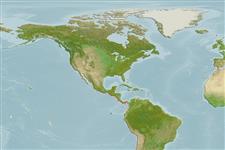Environment: milieu / climate zone / depth range / distribution range
Écologie
marin; eau douce; saumâtre démersal. Tropical; 25°C - 30°C (Ref. 36880)
Eastern Central Pacific: rivers near Tepic, Mexico, to the Rio Copalita near Puerto Angel in the south of Mexico, Pacific drainage. From the Río Pozo Salado, Playa Naranjo to the Río Jicote, near Loma, Costa Rica (Ref. 36880).
Taille / Poids / Âge
Maturity: Lm ? range ? - ? cm
Max length : 28.0 cm SL mâle / non sexé; (Ref. 50190)
Inhabit rivers and creeks of low to moderate current velocity. A benthic piscivore (Ref. 36880).
Life cycle and mating behavior
Maturité | Reproduction | Frai | Œufs | Fécondité | Larves
Hoese, D.F., 1995. Eleotridae. Durmientes. p. 1062-1064. In W. Fischer, F. Krupp, W. Schneider, C. Sommer, K.E. Carpenter and V. Niem (eds.) Guia FAO para Identification de Especies para lo Fines de la Pesca. Pacifico Centro-Oriental. 3 Vols. FAO, Rome. (Ref. 9296)
Statut dans la liste rouge de l'IUCN (Ref. 130435: Version 2024-2)
Menace pour l'homme
Harmless
Utilisations par l'homme
Outils
Articles particuliers
Télécharger en XML
Sources Internet
Estimates based on models
Preferred temperature (Ref.
123201): 26.9 - 29.2, mean 28.5 °C (based on 55 cells).
Phylogenetic diversity index (Ref.
82804): PD
50 = 0.6250 [Uniqueness, from 0.5 = low to 2.0 = high].
Bayesian length-weight: a=0.00603 (0.00286 - 0.01269), b=3.10 (2.91 - 3.29), in cm total length, based on LWR estimates for this (Sub)family-body shape (Ref.
93245).
Niveau trophique (Ref.
69278): 3.5 ±0.6 se; based on size and trophs of closest relatives
Résilience (Ref.
120179): Milieu, temps minimum de doublement de population : 1,4 à 4,4 années (Preliminary K or Fecundity.).
Fishing Vulnerability (Ref.
59153): Low vulnerability (24 of 100).
